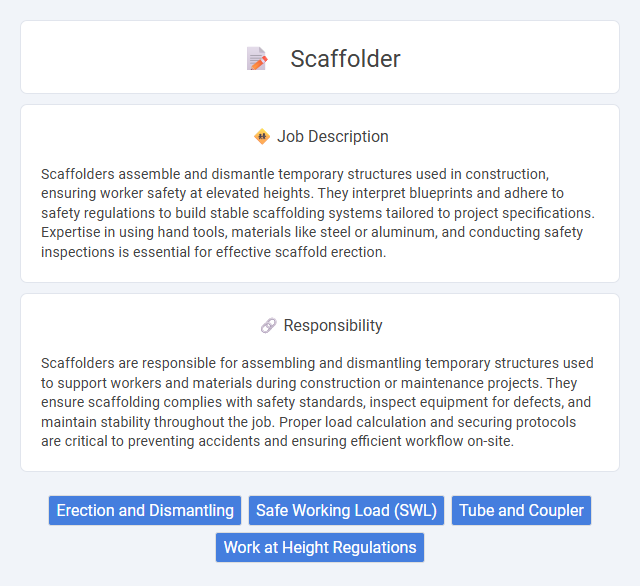
Scaffolders assemble and dismantle temporary structures used in construction, ensuring worker safety at elevated heights. They interpret blueprints and adhere to safety regulations to build stable scaffolding systems tailored to project specifications. Expertise in using hand tools, materials like steel or aluminum, and conducting safety inspections is essential for effective scaffold erection.
Individuals with good physical fitness and strong coordination are likely suitable for scaffolder jobs, as the role demands climbing, lifting, and working at heights. Those who may have a fear of heights or limited stamina might find this occupation challenging. Safety awareness and the ability to follow strict protocols probably increase a person's compatibility with scaffolding work.
Qualification
Scaffolders require specialized training in constructing, assembling, and dismantling temporary structures used in construction to ensure worker safety at heights. Certification from recognized bodies such as CISRS (Construction Industry Scaffolders Record Scheme) is essential, along with knowledge of health and safety regulations and physical fitness for handling heavy materials. Practical experience combined with skills in interpreting technical drawings and operating scaffolding tools enhances job performance and safety compliance.
Responsibility
Scaffolders are responsible for assembling and dismantling temporary structures used to support workers and materials during construction or maintenance projects. They ensure scaffolding complies with safety standards, inspect equipment for defects, and maintain stability throughout the job. Proper load calculation and securing protocols are critical to preventing accidents and ensuring efficient workflow on-site.
Benefit
Scaffolder jobs likely offer competitive wages due to high demand and specialized skills required. Employment in this field might provide opportunities for career advancement and certification, enhancing long-term job security. Benefits may also include physical fitness improvement and work experience in versatile construction environments.
Challenge
Scaffolder jobs likely present significant physical and technical challenges, requiring precise assembly and disassembly at varying heights under strict safety standards. There is a strong probability of encountering unpredictable weather and complex structural environments, demanding quick adaptation and problem-solving skills. Meeting deadlines while ensuring stability and compliance may also contribute to the job's demanding nature.
Career Advancement
Scaffolders can advance their careers by gaining certifications such as CISRS or SSP, which increase employability and access to higher-paying roles. Experience in complex scaffold systems and leadership skills may lead to supervisory or site management positions. Continuous professional development through safety and technical training ensures long-term career growth in the construction industry.
Key Terms
Erection and Dismantling
Scaffolders specialize in the erection and dismantling of temporary structures that support construction, maintenance, and repair activities, ensuring safety and structural integrity throughout the process. They interpret blueprints and specifications to assemble scaffolding efficiently while adhering to industry regulations and safety standards such as OSHA and CISRS. Mastery in handling various materials like steel tubes, couplers, and boards is essential to complete tasks on time and maintain a secure work environment.
Safe Working Load (SWL)
Scaffolders must rigorously adhere to the Safe Working Load (SWL) to ensure structural stability and prevent accidents on construction sites. The SWL represents the maximum load a scaffold can safely support, including workers, materials, and equipment, and exceeding this limit can lead to catastrophic failures. Proper training in load assessment and continuous monitoring of scaffold conditions are critical for maintaining compliance with safety regulations and safeguarding the work environment.
Tube and Coupler
A Scaffolder specializing in Tube and Coupler systems assembles modular scaffolding structures using steel tubes and couplers to ensure robust, adaptable support at construction sites. Expertise in selecting the correct coupler types--right-angle, swivel, and sleeve clamps--maximizes structural integrity and safety compliance. Precision in erecting and dismantling tube and coupler scaffolds enhances efficiency while adhering to strict occupational health and safety regulations.
Work at Height Regulations
Scaffolders must strictly adhere to Work at Height Regulations to ensure safety when constructing and dismantling scaffolding structures. Compliance involves using appropriate fall protection equipment, securing platforms, and conducting thorough risk assessments to prevent accidents. Understanding and implementing these regulations minimizes hazards associated with elevated work environments.
 kuljobs.com
kuljobs.com